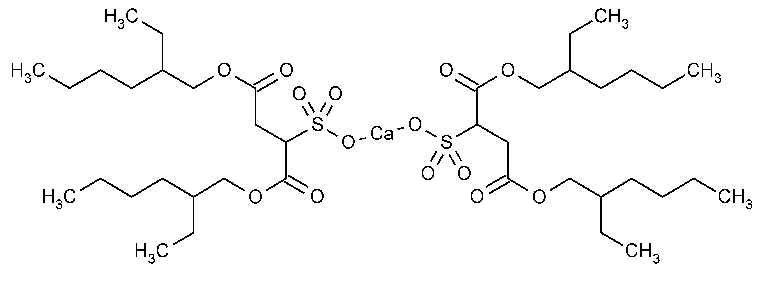Docusate Calcium
Butanedioic acid,sulfo-,1,4-bis(2-ethylhexyl)ester,calcium salt.
1,4-Bis(2-ethylhexyl)sulfosuccinate,calcium salt [128-49-4].
»Docusate Calcium contains not less than 91.0percent and not more than 100.5percent of C40H74CaO14S2,calculated on the anhydrous basis.
Packaging and storage—
Preserve in well-closed containers.
USP Reference standards á11ñ—
USP Docusate Calcium RS.USP Bis(2-ethylhexyl)maleate RS.
Clarity of solution—
Dissolve 25g in 94mLof alcohol:the solution does not develop a haze within 24hours when maintained at a temperature of 25±1 .
.
Identification—
A:
Place a small piece of it on a salt plate,add 1drop of acetone,and promptly cover with another salt plate.Rub the plates together to dissolve the specimen,slide the plates apart,and allow the acetone to evaporate:the IRabsorption spectrum of the film so obtained exhibits maxima only at the same wavelengths as that of a similar preparation of USP Docusate Calcium RS.
B:
Dissolve 25mg in 2mLof acetone.Add 2mLof water,mix,and add 2drops of sulfuric acid:a white precipitate is formed.
C:
Prepare a solution of it in isopropyl alcohol containing 10mg per mL,and mix.Apply,with the aid of a stream of nitrogen,10µLof this solution and 10µLof an isopropyl alcohol solution of USP Docusate Calcium RScontaining 10mg per mLto a suitable thin-layer chromatographic plate (see Chromatography á621ñ)coated with a 0.25-mm layer of chromatographic silica gel.Allow the spots to dry,and develop the chromatogram in a solvent system consisting of a mixture of ethyl acetate,ammonium hydroxide,and alcohol (5:2:2)until the solvent front has moved three-fourths of the length of the plate.Remove the plate from the developing chamber,mark the solvent front,and allow the solvent to evaporate.Expose the plate to iodine vapors in a closed chamber for about 30minutes,and locate the spots:the RFvalue of the spot obtained from the test solution corresponds to that obtained from the Standard solution.
Water,Method Iá921ñ:
not more than 2.0%.
Residue on ignition á281ñ:
between 14.5%and 16.5%,calculated on the anhydrous basis.
Heavy metals,Method Iá231ñ—
Transfer 2.0g to a platinum crucible,and ignite until free from carbon.Cool,moisten the residue with 1mLof hydrochloric acid,and evaporate on a steam bath to dryness.Add 2mLof 1Nacetic acid,digest on a steam bath for 5minutes,filter into one of a pair of matched 50-mL,color-comparison tubes,and wash the residue with sufficient water to make 25mL:the limit is 0.001%.
Limit of bis(2-ethylhexyl)maleate—
Electrolyte solution—
In a 250-mLborosilicate glass beaker dissolve 21.2g of lithium perchlorate in 175mLof water,and adjust by the dropwise addition of glacial acetic acid to a pHof 3.0.Transfer to a 200-mLvolumetric flask,dilute with water to volume,and mix.
Sample stock solution—
Transfer the equivalent of 12.5g of anhydrous Docusate Calcium,accurately weighed,to a 150-mLbeaker,add about 85mLof isopropyl alcohol,stir to dissolve,and transfer to a 250-mLvolumetric flask.Rinse the beaker with another 85-mLportion of isopropyl alcohol,stirring,if necessary,to dissolve any residual Docusate Calcium,combine the rinsing with the solution in the volumetric flask,dilute with isopropyl alcohol to volume,and mix.
Standard solution—
Transfer 25mg of USP Bis(2-ethylhexyl)maleate RS,accurately weighed,to a 25-mLvolumetric flask,dissolve in isopropyl alcohol,dilute with isopropyl alcohol to volume,and mix.In a second 100-mLvolumetric flask combine 10.0mLof this solution,50.0mLof Sample stock solution,and 20.0mLof Electrolyte solution,mix,and allow to stand for 2minutes.Dilute with isopropyl alcohol to volume,and mix.
Test solution—
In a 100-mLvolumetric flask combine 50.0mLof Sample stock solutionwith 20.0mLof Electrolyte solution,mix,and allow to stand for 2minutes.Dilute with isopropyl alcohol to volume,and mix.
Procedure—
Transfer a portion of the Test solutionto a polarographic cell,and deaerate by bubbling through the solution,for 15minutes,nitrogen that has previously been passed through isopropyl alcohol.Continue to flush the surface of the solution with the nitrogen,insert the dropping mercury electrode of a suitable polarograph (see Polarography á801ñ),and record the polarogram from -0.9to -1.5volts,using a saturated calomel electrode as the reference electrode.Determine the height of the polarogram at the half-wave potential,at about -1.2volts,measuring from the baseline.From this height subtract the height,at the same potential,of the polarogram obtained from a blank solution prepared by diluting 20.0mLof Electrolyte solutionwith isopropyl alcohol to 100mLin a volumetric flask and mixing.Designate this corrected height as HT.Concomitantly and similarly determine the height of the polarogram of the Standard solution,and subtract the blank value from it.Designate the result as HS.The value,HT,is not greater than one-half HS,corresponding to not more than 0.4%of bis(2-ethylhexyl)maleate.
Assay—
Tetra-n-butylammonium iodide solution—
Transfer 1.250g of tetra-n-butylammonium iodide to a 500-mLvolumetric flask,dilute with water to volume,and mix.
Salt solution—
Transfer 100g of anhydrous sodium sulfate and 10g of sodium carbonate to a 400-mLbeaker,and add sufficient water to dissolve the two salts.Transfer the solution to a 1000-mLvolumetric flask,dilute with water to volume,and mix.
Procedure—
Dissolve about 50mg of Docusate Calcium,accurately weighed,in 50mLof chloroform in a glass-stoppered,250-mLconical flask.Add 50mLof Salt solutionand 500µLof bromophenol blue TS,and mix.Titrate with Tetra-n-butylammonium iodide solutionuntil about 1mLfrom the endpoint,and shake the stoppered flask vigorously for about 2minutes.Continue the titration in 2-drop increments,shaking vigorously for about 10seconds after each addition,and then allow the flask to stand about 10seconds.Continue the titration until the chloroform layer just assumes a blue color.Each mLof Tetra-n-butylammonium iodide solutionis equivalent to 2.989mg of C40H74CaO14S2.
Auxiliary Information—
Staff Liaison:Elena Gonikberg,Ph.D.,Scientist
Expert Committee:(PA4)Pharmaceutical Analysis 4
USP28–NF23Page 683
Phone Number:1-301-816-8251
